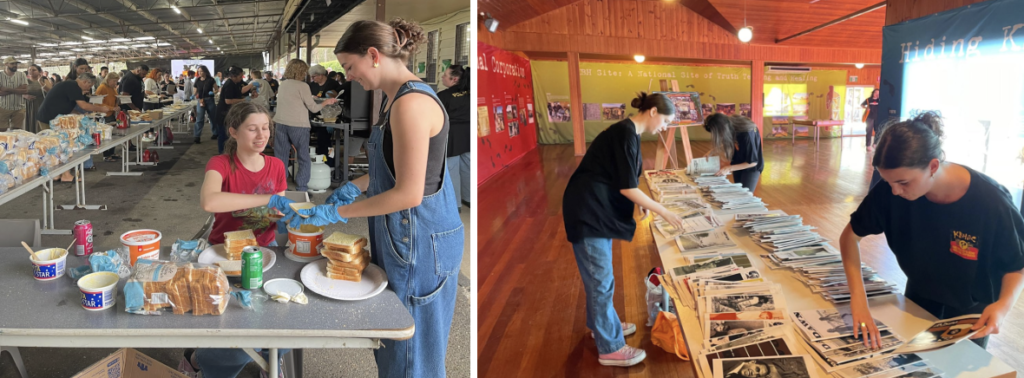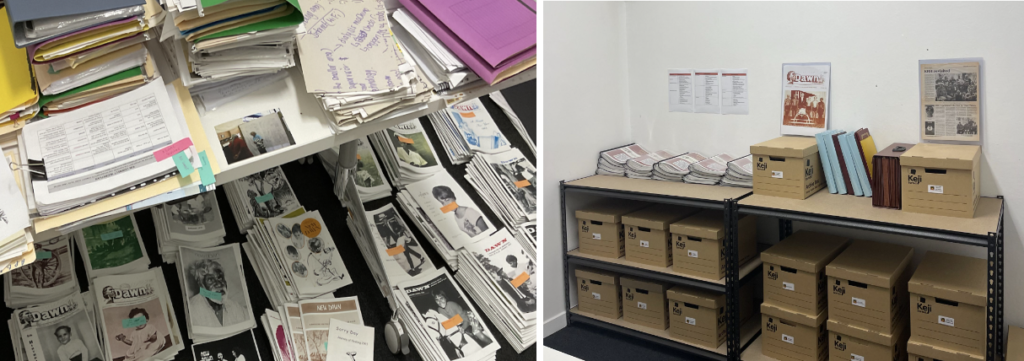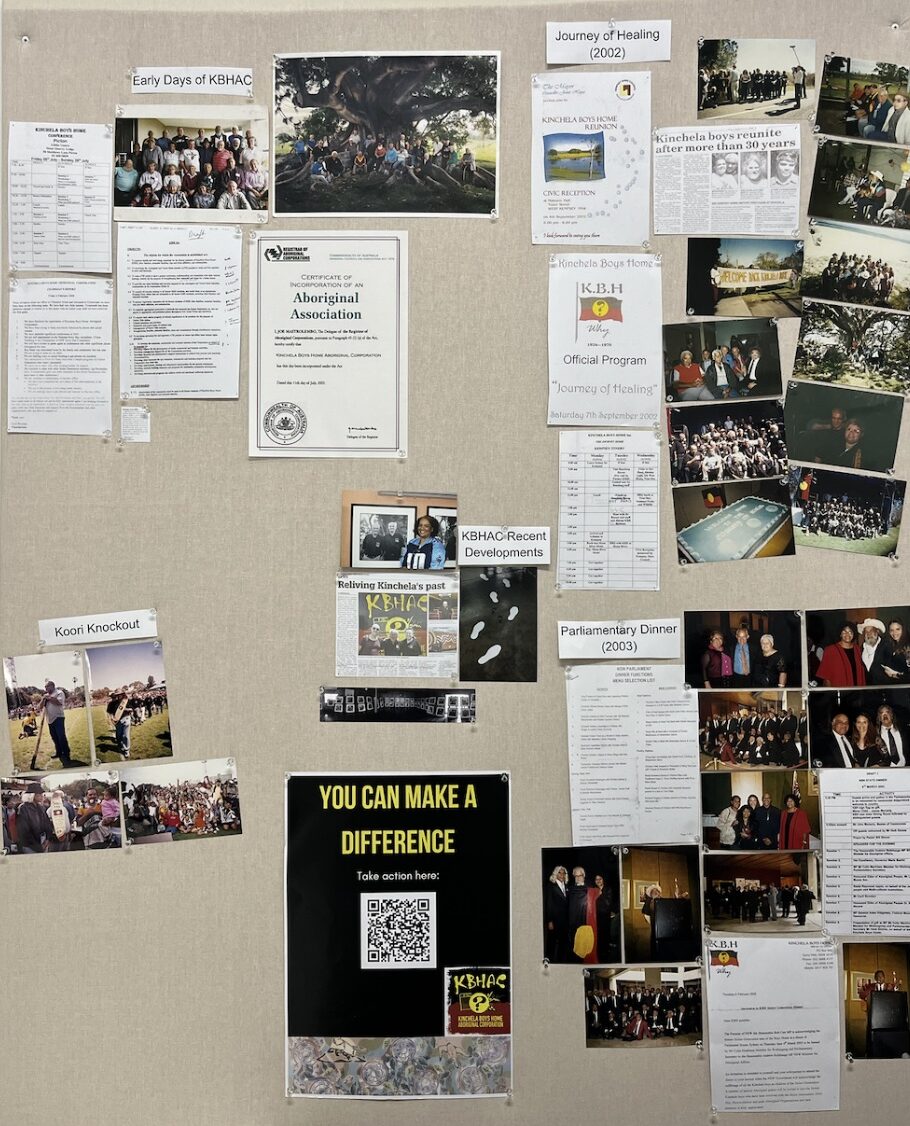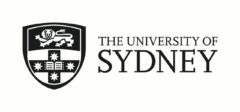I would like to acknowledge the Gadigal people of the Eora Nation, the traditional custodians of the land from which I am writing and pay my respects to the Elders both past and present. I would also like to acknowledge the Dunghutti and other First Nations peoples of this country who were victims of the Australian Government policies that created the Stolen Generations.
This semester I was given the amazing opportunity to work with Kinchela Boys Home Aboriginal Corporation (KBHAC). The aim of the project was to rework an empty office room in the KBHAC headquarters in Waterloo into an archive room and small exhibition space that would document the history of the organisation. The completion of this project would not have been possible without the support of the Uncles, Aunties and descendants who dedicate themselves to KBHAC. A further thanks goes to Jadzia Stronell who was my partner on this project.
Who are KBHAC?
KBHAC is an organisation that was created by and for the survivors of Kinchela Aboriginal Boys Training Home (KBH), a ‘home’ built on the stolen land of the Dunghutti people 20km north-east of Kempsey that housed 400-600 Aboriginal boys forcibly removed from their families by the NSW Government under an assimilation project that lasted from 1924–1970. KBHAC aims to help these men to restore their identities and lives, and to address the impacts of intergenerational trauma felt by the families and descendants of KBH survivors.
The extensive offerings of this organisation to its community, in its many services, community engagement and professional research, means that completing tasks such as developing a room to archive their founding documents ends up on the back burner. However, this organisation has emerged from such a powerful history that should never be forgotten. This mission becomes especially important when considering that KBH is severely under researched, and the information that is available to the public, and even to survivors and descendants is extremely limited. Moreover, the aging demographic of the Uncles of KBH acts as a further imperative for preserving the history of KBH and KBHAC.
You can read more about KBH and KBHAC through via the organisations website https://kinchelaboyshome.org.au/
The Project
From the early days of working on this project, Jadzia and I felt it was crucial to keep the KBHAC community at the centre of our project. In order to do this, we wanted to demonstrate our interest in the organisation by volunteering at the KBH 100th Anniversary weekend in Kempsey. The weekend featured the buttering of countless slices of bread. But also many meaningful moments such as getting to see the Uncles walk through the KBH gate and talk about how far they have come, to getting to see the younger generations playing in the yard of KBH, a place of many painful memories for their elders. This experience really highlighted the healing process that organisations such as KBHAC are so crucial in nurturing. This experience also shaped our understanding that the final project should focus on the countless achievements of KBHAC and the strength of survivors, rather than on the traumas that have been experienced by this community.

To see more photographs from the KBH 100th Anniversary, such as the uncles walking through the KBH gate, please see the KBHAC social media.
The project began with piles and piles of photographs and documents that KBHAC staff wished for us to organise into an ‘archive room’. This source material had been stored by various members of the organisation since its founding in 2002, with the documents ranging from inaugural meeting minutes to old newspaper clippings. However, the disarray of the documents meant that they were limited in their usefulness. The sorting process took place across our nine weeks working with the organisation, with the documents eventually being sorted into themes (e.g.: general events and founding). With the support of KBHAC, we were able to purchase materials for the room which included a shelf, archive boxes, folders, photo albums and display folders. The finalised archive room consisted of 15 categorised archive boxes, with 110 total subcategories. We also organised the Dawn and New Dawn Magazines into display folders with a cover page that notes the issues included in the folder and a QR code leading to the AIATSIS online repository. Finally, the photographs were sorted with the help of KBHAC staff into events and placed into photo albums.

During the sorting process we identified key events in KBHAC’s history, deciding that some of these events should be displayed in the archive room at KBHAC. These events included the first meeting at Picton, Journey of Healing, Parliamentary Dinner and Koori Knockout. The images and documents that featured on this display were chosen in consultation with Aunty Leslie, Aunty Paulette, Uncle Widdy and Tiffany McComsey. It was a beautiful experience to see people who have been involved with the organisation for such a long-time reminiscing and getting excited about our project. Moreover, it became apparent that many of these documents and photographs had never been seen by the Aunties and Uncles, confirming the importance of our project. The main takeaway from this conversation was that the Aunties and Uncles were grateful we were there and showing genuine interest in their work at KBHAC, reaching the conclusion that so long as we were thoughtful in our final project, the organisation would be grateful.

Furthermore, we acknowledged that KBH survivors and descendants are spread across Australia hence many would not frequent the KBHAC office to see the archive room. Yet, we felt it was important for those most linked to KBHAC to have access and ownership over their history. For this reason, we digitised some sources, which were selected in consultation with KBHAC staff. The time constraints of the project meant that we were only able to digitise 27 sources, which exist on a spreadsheet that displays a digitised version of the source and an approximate 100-word description. The hope is that in time these sources can be moved onto the KBHAC website and social media pages.
The work done by survivors and descendants at KBHAC is incredibly valuable and must be remembered. Believing that I had a slight role in supporting such an important organisation is an experience I will carry with me forever. Moreover, there is still much work to be done in the KBHAC office which is why Jadzia and I intend to return in the New Year. In our continued work we plan to put up a timeline of KBHAC’s establishment, continue to sort through any remaining documents, develop the exhibition space further, and aid in the publishing of digitised source material.

